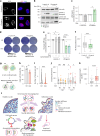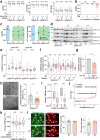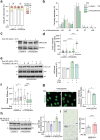Chromosome mis-segregation triggers cell cycle arrest through a mechanosensitive nuclear envelope checkpoint
- PMID: 39779939
- PMCID: PMC11735390
- DOI: 10.1038/s41556-024-01565-x
Chromosome mis-segregation triggers cell cycle arrest through a mechanosensitive nuclear envelope checkpoint
Abstract
Errors during cell division lead to aneuploidy, which is associated with genomic instability and cell transformation. In response to aneuploidy, cells activate the tumour suppressor p53 to elicit a surveillance mechanism that halts proliferation and promotes senescence. The molecular sensors that trigger this checkpoint are unclear. Here, using a tunable system of chromosome mis-segregation, we show that mitotic errors trigger nuclear deformation, nuclear softening, and lamin and heterochromatin alterations, leading to rapid p53/p21 activation upon mitotic exit in response to changes in nuclear mechanics. We identify mTORC2 and ATR as nuclear deformation sensors upstream of p53/p21 activation. While triggering mitotic arrest, the chromosome mis-segregation-induced alterations of nuclear envelope mechanics provide a fitness advantage for aneuploid cells by promoting nuclear deformation resilience and enhancing pro-invasive capabilities. Collectively, this work identifies a nuclear mechanical checkpoint triggered by altered chromatin organization that probably plays a critical role in cellular transformation and cancer progression.
© 2025. The Author(s).
Conflict of interest statement
Competing interests: The authors declare no competing interests.
Figures













Similar articles
-
Survivin safeguards chromosome numbers and protects from aneuploidy independently from p53.Mol Cancer. 2014 May 9;13:107. doi: 10.1186/1476-4598-13-107. Mol Cancer. 2014. PMID: 24886358 Free PMC article.
-
Nuclear envelope structural defect underlies the main cause of aneuploidy in ovarian carcinogenesis.BMC Cell Biol. 2016 Nov 22;17(1):37. doi: 10.1186/s12860-016-0114-8. BMC Cell Biol. 2016. PMID: 27875985 Free PMC article.
-
MAD2 depletion triggers premature cellular senescence in human primary fibroblasts by activating a p53 pathway preventing aneuploid cells propagation.J Cell Physiol. 2012 Sep;227(9):3324-32. doi: 10.1002/jcp.24030. J Cell Physiol. 2012. PMID: 22170163
-
Less understood issues: p21(Cip1) in mitosis and its therapeutic potential.Oncogene. 2015 Apr 2;34(14):1758-67. doi: 10.1038/onc.2014.133. Epub 2014 May 26. Oncogene. 2015. PMID: 24858045 Review.
-
Aneuploidy and tumorigenesis.Semin Cell Dev Biol. 2011 Aug;22(6):595-601. doi: 10.1016/j.semcdb.2011.03.002. Epub 2011 Mar 15. Semin Cell Dev Biol. 2011. PMID: 21392584 Free PMC article. Review.
Cited by
-
Misshapen chromosomes in check by mechanics.Nat Cell Biol. 2025 Jan;27(1):9-11. doi: 10.1038/s41556-024-01573-x. Nat Cell Biol. 2025. PMID: 39695243 No abstract available.
-
Mechanosensitive nuclear checkpoint: nuclear envelope as a sensor of chromosomal instability and driver of cell fate.Mechanobiol Med. 2025 May 21;3(2):100135. doi: 10.1016/j.mbm.2025.100135. eCollection 2025 Jun. Mechanobiol Med. 2025. PMID: 40510846 Free PMC article.
-
Developing a novel aging assessment model to uncover heterogeneity in organ aging and screening of aging-related drugs.Genome Med. 2025 Jul 24;17(1):83. doi: 10.1186/s13073-025-01501-0. Genome Med. 2025. PMID: 40708007 Free PMC article.
-
USP25-driven KIFC1 regulates MYCBP expression and promotes the progression of cervical cancer.Cell Death Dis. 2025 May 16;16(1):390. doi: 10.1038/s41419-025-07713-x. Cell Death Dis. 2025. PMID: 40379626 Free PMC article.
-
Peripheral chromatin remodeling at the center of zygotic genome activation.Cell Genom. 2025 Jul 9;5(7):100922. doi: 10.1016/j.xgen.2025.100922. Cell Genom. 2025. PMID: 40639342 Free PMC article.
References
-
- Santaguida, S. & Amon, A. Short- and long-term effects of chromosome mis-segregation and aneuploidy. Nat. Rev. Mol. Cell Biol.16, 473–485 (2015). - PubMed
-
- Gordon, D. J., Resio, B. & Pellman, D. Causes and consequences of aneuploidy in cancer. Nat. Rev. Genet.13, 189–203 (2012). - PubMed
-
- Hafner, A., Bulyk, M. L., Jambhekar, A. & Lahav, G. The multiple mechanisms that regulate p53 activity and cell fate. Nat. Rev. Mol. Cell Biol.20, 199–210 (2019). - PubMed
MeSH terms
Substances
Grants and funding
LinkOut - more resources
Full Text Sources
Research Materials
Miscellaneous

